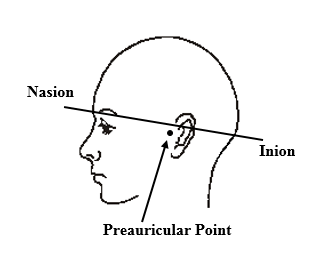Cleveland Family Study
17.8.3.1 Identify Your Landmarks
- Pre-auricular points: Standing at the side of the participant, look at the ear. In front of the ear canal is a small flap of cartilage called the tragus. Just above the tragus is the point at which the top of ear lobe begins to form. The small dimple-like indentation between the tragus and the formation of the top of the ear lobe is the pre-auricular point. If in doubt, ask the participant to open and close his jaw. Look and feel for movement at the indentation above the tragus. Using blue china marker, lightly mark these landmarks on both the right and left sides of the participant.
- Nasion: Facing the participant, look into his/her eyes. Find the small dip at the bridge of the nose between the eyes. This point at which the forehead meets the nose is the nasion. Lightly mark the nasion.
- Inion: Using a comb, unpadded cotton swab end or hair clip part the participant’s hair down the center, in the back of the head. Starting at the nape of the neck, run a finger up the back of the participant’s head until a bony ridge, or bump, can be felt. Having the participant move his/her head up and down may help you to identify this bony ridge. The slight hollow just beneath this bony ridge is the inion. Lightly mark the inion. This landmark may be difficult to feel on some individuals.
When the inion cannot be determined use the following method:
- Re-identify the nasion, which has been lightly marked.
- Re-identify both pre-auricular landmarks, which have been lightly marked.
- Standing on the side of the participant, visualize an imaginary line forming a band around the head, using the nasion and preauricular sites that have been marked. The back of this imaginary band should identify the inion. Mark the inion lightly.
